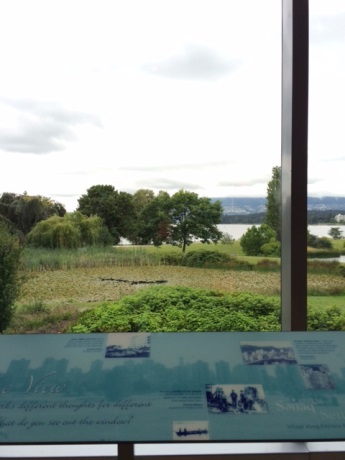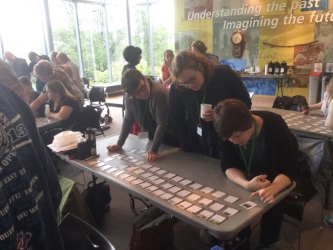
View out the classroom window from the Museum of Vancouver
Attending the Historical Thinking Summer Institute at the Museum of Vancouver was mind-blowing for me on several levels, least of which was that my youthful association with the location.
Back in the day, the site’s most prominent inhabitant, The Planetarium, was known far and wide to teenagers all over BC’s lower mainland as the place to see the ‘star show’, which entailed some kind of animated replica of galaxies projected onto The Planetarium’s ceiling. The entire experience was accompanied by Pink Floyd’s Dark Side of the Moon.
These days, The Planetarium operates quite independently of the museum and has been renamed H.R. MacMillan Space Centre and the Museum of Vancouver stands on its own as an important cultural player in the life of Vancouver, despite people like me who still associate it with Pink Floyd.
But no more. After attending the Summer Institute, I can report that I now associate the site with more than Pink Floyd. I was at the Summer Institute to deepen my understanding of historical thinking concepts, a framework for teaching history and creating learning experiences about history, that we are already applying to programming at the Royal BC Museum.

Historical Thinking Summer Institute participants prioritizing events in Canadian history and exploring the question ‘What is historically significant and who gets to decide?’ Photo credit: Lindsay Gibson
What are historical thinking concepts?
Historical thinking concepts are essentially the framework that historians use to construct history, broken into distinct elements to help students think about the process. Recently retired University of British Columbia professor Peter Seixas and veteran teacher Tom Morton have presented the historian thinking in their aptly named book The Big Six Historical Thinking Concepts. The ideas in this book have been widely applied to curricula across Canada and particularly to BC ‘s new social studies curriculum.
The historical thinking concepts are:
- Historical significance: What and who should be remembered, researched and taught?
- Evidence: Is the evidence credible and adequate to support the conclusions reached?
- Continuity and change: How are lives and conditions alike over time and how have they changed?
- Cause and consequence: Why did historical events happen the way they did and what are the consequences?
- Historical perspective: What does past look like when viewed through lenses of the time?
- The Ethical Dimension: Is what happened right and fair?
(From: Thinking Historically Reference Guide)
Scientists use scientific methods to reach their conclusions. Historians use historical thinking concepts to reach theirs. Unlike in science education, in history classes there has been little to no emphasis on how historians work. Using historical thinking concepts shifts the focus from content, the events of history, to instead the process and issues that historians grapple with in their work.
Teaching history from this perspective brings history classes to life in a very practical way. Learning to think like an historian is about learning to think critically. Critical thinking skills are a key part of 21st century learning, the foundation for BC’s new K-12 school curriculum. As one of my classmates put it, historical thinking concepts are life skills.
During the Summer Institute we left the classroom for two enriching field trips. The first was to the Gulf of Georgia Cannery National Historic Site and the second was a walking tour of Vancouver with John Atkin. Both excursions gave us the chance to see historical thinking concepts exemplified. At historic sites and in history tours, just like in creating museum exhibitions, decisions are made about which historical narratives to present. It was useful to experience the fieldtrips with the lens of historical thinking and discuss with classmates while we were deep in our exploration of the concepts.
On the final day of the Historical Thinking Summer Institute, we presented our group projects to each other. It was inspiring to be in a room with all that passion and brain power. One of my classmates, Vancouver teacher Craig Brumwell, posted about the Summer Institute on his blog here.
Back at the museum, there is much relevance to our work in the learning department. Programming ideas are percolating that will complement BC’s school curriculum and enrich online materials on the Learning Portal and for our new Digital Fieldtrips. The Summer Institute confirmed for me that we are on the right track with our Learning Portal and other online resources. Teachers want to use primary sources as historical evidence in the classroom. We already provide these digitally through the Learning Portal, 100 Objects of Interest and Transcribe sites. We will continue to add digitized copies of primary sources such as photographs and letters to these sites. In the Learning department, we will continue to reach out to schools across the province to connect them with the learning materials and experiences they need.
Personally, I will reflect on the the historical thinking concept continuity and change and leave Pink Floyd out of it.
(The Critical Thinking Consortium has a series of short videos to introduce historical thinking concepts to teachers and students here.)


